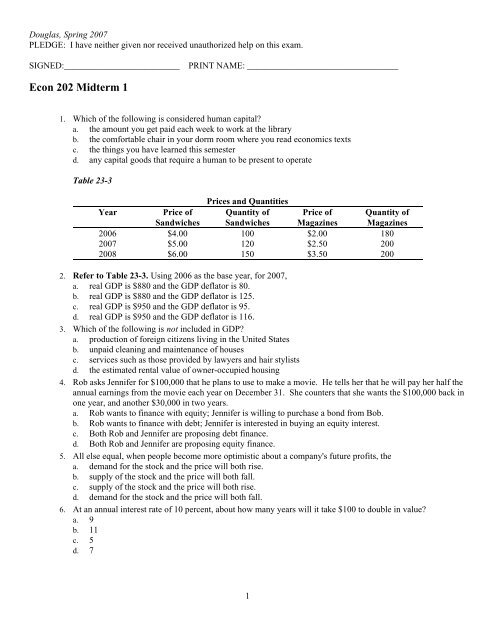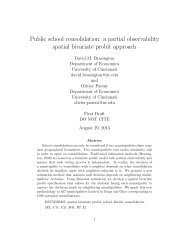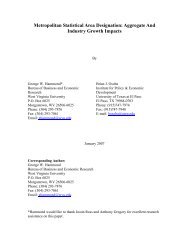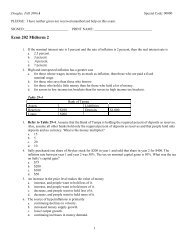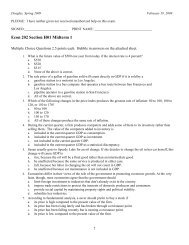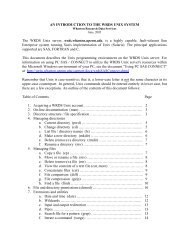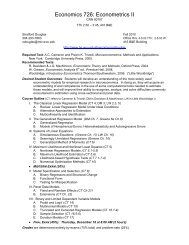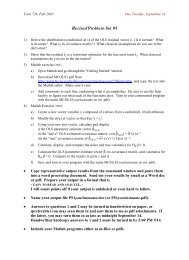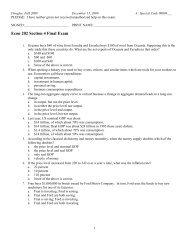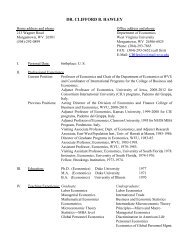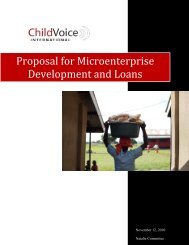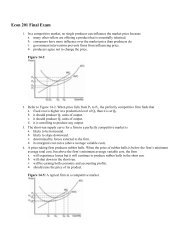Econ 202 Midterm 1
Econ 202 Midterm 1
Econ 202 Midterm 1
Create successful ePaper yourself
Turn your PDF publications into a flip-book with our unique Google optimized e-Paper software.
Douglas, Spring 2007<br />
PLEDGE: I have neither given nor received unauthorized help on this exam.<br />
SIGNED:__________________________<br />
PRINT NAME: __________________________________<br />
<strong>Econ</strong> <strong>202</strong> <strong>Midterm</strong> 1<br />
1. Which of the following is considered human capital?<br />
a. the amount you get paid each week to work at the library<br />
b. the comfortable chair in your dorm room where you read economics texts<br />
c. the things you have learned this semester<br />
d. any capital goods that require a human to be present to operate<br />
Table 23-3<br />
Prices and Quantities<br />
Year<br />
Price of<br />
Sandwiches<br />
Quantity of<br />
Sandwiches<br />
Price of<br />
Magazines<br />
Quantity of<br />
Magazines<br />
2006 $4.00 100 $2.00 180<br />
2007 $5.00 120 $2.50 200<br />
2008 $6.00 150 $3.50 200<br />
2. Refer to Table 23-3. Using 2006 as the base year, for 2007,<br />
a. real GDP is $880 and the GDP deflator is 80.<br />
b. real GDP is $880 and the GDP deflator is 125.<br />
c. real GDP is $950 and the GDP deflator is 95.<br />
d. real GDP is $950 and the GDP deflator is 116.<br />
3. Which of the following is not included in GDP?<br />
a. production of foreign citizens living in the United States<br />
b. unpaid cleaning and maintenance of houses<br />
c. services such as those provided by lawyers and hair stylists<br />
d. the estimated rental value of owner-occupied housing<br />
4. Rob asks Jennifer for $100,000 that he plans to use to make a movie. He tells her that he will pay her half the<br />
annual earnings from the movie each year on December 31. She counters that she wants the $100,000 back in<br />
one year, and another $30,000 in two years.<br />
a. Rob wants to finance with equity; Jennifer is willing to purchase a bond from Bob.<br />
b. Rob wants to finance with debt; Jennifer is interested in buying an equity interest.<br />
c. Both Rob and Jennifer are proposing debt finance.<br />
d. Both Rob and Jennifer are proposing equity finance.<br />
5. All else equal, when people become more optimistic about a company's future profits, the<br />
a. demand for the stock and the price will both rise.<br />
b. supply of the stock and the price will both fall.<br />
c. supply of the stock and the price will both rise.<br />
d. demand for the stock and the price will both fall.<br />
6. At an annual interest rate of 10 percent, about how many years will it take $100 to double in value?<br />
a. 9<br />
b. 11<br />
c. 5<br />
d. 7<br />
1
<strong>Econ</strong><strong>202</strong> Exam 1, Spring 2007<br />
Douglas<br />
7. The dictator of a certain country takes some farms away from their owners each year and gives them to his<br />
friends who he sincerely believes are better farmers than the former owners. Other things the same, in the<br />
long run this practice will most likely<br />
a. reduce real GDP per person and reduce productivity.<br />
b. reduce real GDP per person, but increase productivity.<br />
c. increase real GDP per person and increase productivity.<br />
d. increase real GDP per person, but decrease productivity.<br />
8. Birdfeeders are normal goods. What will happen to the equilibrium price of birdfeeders if consumers<br />
experience an increase in income, the price of bird food falls, and the number of birdfeeder manufacturers<br />
falls?<br />
a. Price will stay exactly the same.<br />
b. Price will rise.<br />
c. Price will fall.<br />
d. The price change will be ambiguous.<br />
Table 23-2. The information in the table pertains to the country of Ophir.<br />
Year Nominal GDP GDP Deflator<br />
2004 $4000 100<br />
2005 $4100 105<br />
2006 $4200 110<br />
9. Refer to Table 23-2. Rank the years from highest Real GDP to lowest Real GDP:<br />
a. 2004 is highest, then 2005, and 2006 is lowest.<br />
b. 2006 is highest, then 2005, and 2004 is lowest.<br />
c. 2004 is highest, then 2006, and 2005 is lowest.<br />
d. 2005 is highest, then 2004, and 2006 is lowest.<br />
10. The current price of neckties is $30 and the equilibrium price of neckties is $25. As a result,<br />
a. There is currently a surplus of neckties.<br />
b. the equilibrium quantity of neckties exceeds the quantity demanded at the $30 price.<br />
c. the current quantity supplied of neckties exceeds the quantity demanded of neckties.<br />
d. All of the above are correct.<br />
11. In a closed economy, what does (T - G) represent?<br />
a. national saving<br />
b. public saving<br />
c. investment<br />
d. private saving<br />
2
<strong>Econ</strong><strong>202</strong> Exam 1, Spring 2007<br />
Douglas<br />
Table 2-1. Production Possibilities for Toyland<br />
Dolls Fire Trucks<br />
400 0<br />
300 200<br />
200 350<br />
100 450<br />
0 500<br />
12. In Table 2-1, what is the opportunity cost of increasing the production of dolls from 200 to 300?<br />
a. It is impossible to tell what the opportunity cost is since in this example costs are not<br />
constant.<br />
b. 100 fire trucks<br />
c. 150 fire trucks<br />
d. 200 fire trucks<br />
13. What is the present value of a payment of $200 to be made one year from today if the interest rate is 10<br />
percent?<br />
a. $181.82<br />
b. $220<br />
c. $180<br />
d. $222.22<br />
14. Compared to long-term bonds, other things the same, short-term bonds generally have<br />
a. about the same risk and so pay about the same interest.<br />
b. more risk and so pay higher interest.<br />
c. less risk and so pay higher interest.<br />
d. less risk and so pay lower interest.<br />
Table 24-4<br />
The table below pertains to an economy with only two goods -- books and calculators. The fixed basket<br />
consists of 5 books and 10 calculators.<br />
Year Price of books Price of calculators<br />
2006 $24 $8<br />
2007 30 12<br />
2008 32 15<br />
15. Refer to Table 24-4. Using 2006 as the base year, the consumer price index is<br />
a. 100 in 2006, 135 in 2007, and 155 in 2008.<br />
b. 200 in 2006, 270 in 2007, and 310 in 2008.<br />
c. 100 in 2006, 270 in 2007, and 310 in 2008.<br />
d. 200 in 2006, 540 in 2007, and 620 in 2008.<br />
16. If the consumer price index was 100 in the base year and 107 in the following year, the inflation rate was<br />
a. 107 percent.<br />
b. 10.7 percent.<br />
c. 7 percent.<br />
d. 1.07 percent.<br />
3
<strong>Econ</strong><strong>202</strong> Exam 1, Spring 2007<br />
Douglas<br />
17. Which of the following is correct?<br />
a. If a relatively poor country had grown at 3.5 percent per year for the last 100 years, it<br />
would most likely be a relatively rich country today.<br />
b. In the United States, average income today is about twice as high as it was a century ago.<br />
c. International data on the history of the growth of real GDP per person shows that the rich<br />
countries get richer and the poor countries get poorer.<br />
d. All of the above are correct.<br />
18. Which of the following items is included in GDP?<br />
a. the sale of services such as those performed by a doctor<br />
b. the sale of stocks and bonds<br />
c. the sale of used goods<br />
d. All of the above are included in GDP.<br />
19. Suppose a closed economy had public saving of $1 trillion and investment of $6 trillion. Consumption is $7<br />
trillion and GDP is $14 trillion. What is private saving in this country?<br />
a. $5 trillion<br />
b. $7 trillion<br />
c. $1 trillion.<br />
d. $6 trillion<br />
20. Which of the following events could shift the demand curve for gasoline to the left?<br />
a. The price of gasoline rises.<br />
b. Income of gasoline buyers falls, and gasoline is an inferior good.<br />
c. Income of gasoline buyers rises, and gasoline is a normal good.<br />
d. The price of tires rises.<br />
21. If you put $300 into an account paying 2 percent interest and let the interest accumulate without withdrawing<br />
it, what will be the value of this account in two years?<br />
a. $312<br />
b. $314.24<br />
c. $310<br />
d. $312.12<br />
22. You are expecting to receive $750 at some time in the future. Which of the following would unambiguously<br />
increase the present value of this future payment?<br />
a. Interest rates rise and you get the payment sooner.<br />
b. Interest rates fall and you get the payment sooner.<br />
c. Interest rates rise and you have to wait longer for the payment.<br />
d. Interest rates fall and you have to wait longer to get the payment.<br />
23. In a certain economy in 2005, GDP amounted to $5,000; consumption amounted to $3,000; investment was<br />
$900; and the value of imports exceeded the value of exports by $200. Taxes collected were $900. It follows<br />
that government purchases amounted to<br />
a. $2200.<br />
b. $900.<br />
c. $400.<br />
d. $1300.<br />
24. Goods that go into inventory and are not sold during the current period are<br />
a. included in current period GDP as consumption.<br />
b. counted in current GDP only if the firm that produced them sells them to another firm.<br />
c. included in current period GDP as inventory investment.<br />
d. counted as intermediate goods and so are not included in current period GDP.<br />
4
<strong>Econ</strong><strong>202</strong> Exam 1, Spring 2007<br />
Douglas<br />
25. The primary advantage of mutual funds is that they<br />
a. allow people with small amounts of money to diversify.<br />
b. always make a return that "beats the market."<br />
c. provide customers with a medium of exchange.<br />
d. All of the above are correct.<br />
26. If Susan quits going to Speedy Lube and starts changing the oil in her old car herself, she will cause GDP to<br />
a. rise.<br />
b. fall.<br />
c. be unaffected because the same service is produced in either case.<br />
d. be unaffected because maintenance on old cars is not included in GDP.<br />
27. What would happen to the equilibrium price and quantity of cotton shirts if the price of cotton fell and the<br />
price of silk shirts fell?<br />
a. Price will rise and the effect on quantity is ambiguous.<br />
b. Price will fall and the effect on quantity is ambiguous.<br />
c. Quantity will rise and the effect on price is ambiguous.<br />
d. Quantity will fall and the effect on price is ambiguous.<br />
28. In the circular-flow diagram,<br />
a. spending on goods and services flows from firms to households.<br />
b. income paid to the factors of production flows from firms to households.<br />
c. goods and services flow from households to firms.<br />
d. factors of production flow from government to firms.<br />
29. When supply and demand both increase, equilibrium<br />
a. price may increase, decrease, or remain unchanged.<br />
b. quantity may increase, decrease, or remain unchanged.<br />
c. price will definitely decrease.<br />
d. price will definitely increase.<br />
30. Suppose the price of gasoline increases rapidly, and consumers respond by buying a smaller quantity of<br />
gasoline. The consumer price index<br />
a. will accurately reflect inflation.<br />
b. will overstate inflation due to the so-called substitution bias.<br />
c. will overstate inflation due to the so-called income bias.<br />
d. will understate inflation due to the so-called substitution bias.<br />
5
<strong>Econ</strong><strong>202</strong> Exam 1, Spring 2007<br />
Douglas<br />
Short Essay Question. Answer all three parts in the space provided.<br />
31. a. In a closed economy, suppose that the government increases spending without raising taxes, and<br />
interest rates subsequently fall. Why is this surprising? Explain briefly in the space below, using a<br />
graph, complete sentence(s), and perhaps a little bit of algebra, why you would expect interest rates<br />
to rise when government spending rises, with taxes held constant.<br />
b. Name one event (e.g., a change in government policy or individual behavior or attitudes) that, if it<br />
occurred simultaneously with the spending increase, could have caused interest rates to fall.<br />
c. If your explanation in part b is correct, then the amount of private investment must have<br />
(circle one) RISEN, FALLEN. Explain your answer below, using a second graph to illustrate.<br />
6
ID: A<br />
<strong>Econ</strong> <strong>202</strong> <strong>Midterm</strong> 1<br />
Answer Section<br />
MULTIPLE CHOICE<br />
1. ANS: C MSC: Definitional<br />
2. ANS: B MSC: Applicative<br />
3. ANS: B MSC: Definitional<br />
4. ANS: A MSC: Interpretive<br />
5. ANS: A MSC: Analytical<br />
6. ANS: D MSC: Applicative<br />
7. ANS: A MSC: Applicative<br />
8. ANS: B MSC: Analytical<br />
9. ANS: A MSC: Applicative<br />
10. ANS: D MSC: Interpretive<br />
11. ANS: B MSC: Definitional<br />
12. ANS: C MSC: Interpretive<br />
13. ANS: A MSC: Applicative<br />
14. ANS: D MSC: Definitional<br />
15. ANS: A MSC: Applicative<br />
16. ANS: C MSC: Interpretive<br />
17. ANS: A MSC: Definitional<br />
18. ANS: A MSC: Interpretive<br />
19. ANS: A MSC: Definitional<br />
20. ANS: D MSC: Interpretive<br />
21. ANS: D MSC: Applicative<br />
22. ANS: B MSC: Analytical<br />
23. ANS: D MSC: Applicative<br />
24. ANS: C MSC: Interpretive<br />
25. ANS: A MSC: Definitional<br />
26. ANS: B MSC: Applicative<br />
27. ANS: B MSC: Applicative<br />
28. ANS: B MSC: Interpretive<br />
29. ANS: A MSC: Applicative<br />
30. ANS: B MSC: Interpretive<br />
PROBLEM<br />
31. ANS:<br />
a. It is surprising because an increase in government spending increases the deficit (makes public<br />
savings T-G fall), which would cause savings to fall, reducing Supply of Loanable Funds. .<br />
b & c. Events that could explain the paradox include a fall in wealth that causes an increase in private<br />
saving (Y-T-C), which would cause I to rise too, or a fall in optimism, which causes a decrease in<br />
Demand for Loanable Funds, which would cause I to fall.<br />
1


